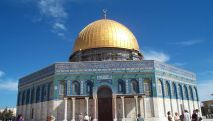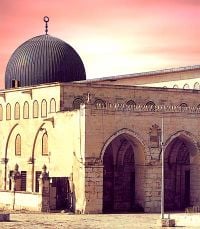Jerusalem assumed significance as an Islamic holy site during the rule of the Umayyads (661-750 CE). Facing challenge to his power from Ibn al-Zubayr, a rebel who controlled Mecca, the Syrian-based Caliph Abd al Malik sought to consolidate his leadership by establishing a place of worship for his followers in Jerusalem in place of Mecca. He built the Dome of the Rock (Masjid Qubbat As Sakhrah) in 688-691 CE on the spot where the Jewish Temples had stood.

Dome of the Rock
Two decades later, in 715 CE, the Umayyads built another mosque on the Temple Mount which they named the Furthest Mosque (Masjid al Aqsa ) to connote the “furthest mosque” alluded to in the Quran (17:1). This was the metaphorical spot from which Mohammed was said to have ascended to heaven in a vision (referred to in Arabic as the Mi’raj) after a night journey from Mecca (the Isra) on a winged steed named Al Buraq.
Although the Quran does not mention Jerusalem or the Temple Mount, the designation of a concrete site to what had been until then just a figurative name provided Muslims with a new religious focus. Several Qur’anic verses were subsequently construed to be obliquely referring to Jerusalem. The Temple Mount was renamed by Muslims the Noble Sanctuary (al Haram al Sharif).

Al Aqsa Mosque
Over the years, Jerusalem’s stature as an Islamic holy city has waxed and waned. During the period between 1948 and 1967 when under Jordanian control, Jerusalem and its holy sites were largely neglected by the Muslim world. Since Israel gained control of East Jerusalem and reunified the city, however, there has been a growing attempt by Palestinians to marshal the religious fervor of the Arab and Muslim world in order to wrest Jerusalem from Israel.

